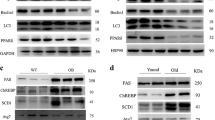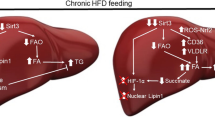Abstract
Purpose
The peroxisome proliferator-activated receptor gamma coactivator-1 alpha (PGC-1α) regulates the expression of genes implicated in fatty acid oxidation and oxidative phosphorylation. Its role in liver steatosis is well established, since mice with liver-specific deletion of PGC-1α exhibit lipid accumulation and high-fat diet reduces hepatic PGC-1α expression in mice. In this study, we investigated the role of PGC-1α in the inflammatory changes observed in steatohepatitis induced by high-fat diet.
Methods
C57black/6 mice were fed a high-fat diet containing 30% fat for 10 weeks. After euthanasia, liver morphology was examined by HE staining and inflammation was determined by IL-6, TNF-α, and IL-1β quantification. Liver gene expression of PGC-1 isoforms was evaluated by real-time PCR and p65 NFκB nuclear translocation by Western blotting. HepG2 cells were treated with linoleic acid overload for 72 h to create an in vitro model of steatohepatitis. RNA interference (RNAi) was used to evaluate the involvement of PGC-1α on inflammatory mediators’ production by hepatocytes.
Results
The high-fat diet led to a state of nonalcoholic steatohepatitis, associated with increased deposits of intra-abdominal fat, hyperglycemia and hyperlipidemia. Mice liver also exhibited increased proinflammatory cytokines’ levels, decreased PGC-1α expression, and marked increase in p65 NFκB nuclear translocation. Linoleic acid treated cells also presented increased expression of proinflammatory cytokines and decreased PGC-1α expression. The knockdown of PGC-1α content caused an increase in IL-6 expression and release via enhanced IκBα phosphorylation and subsequent increase of p65 NFκB nuclear translocation.
Conclusion
High-fat diet induces liver inflammation by inhibiting PGC-1α expression and its suppressive effect in NFκB pathway.









Similar content being viewed by others
References
Marchesini G, Bugianesi E, Forlani G, Cerrelli F, Lenzi M, Manini R, Natale S, Vanni E, Villanova N, Melchionda N, Rizzetto M (2003) Nonalcoholic fatty liver, steatohepatitis, and the metabolic syndrome. Hepatology 37:917–923
Willebrords J, Pereira IV, Maes M, Crespo Yanguas S, Colle I, Van Den Bossche B, Da Silva TC, de Oliveira CP, Andraus W, Alves VA, Cogliati B, Vinken M (2015) Strategies, models and biomarkers in experimental non-alcoholic fatty liver disease research. Prog Lipid Res 59:106–125
Lin J, Handschin C, Spiegelman BM (2005) Metabolic control through the PGC- 1 family of transcription coactivators. Cell Metab 1:361–370
Puigserver P, Wu Z, Park CW, Graves R, Wright M, Spiegelman BM (1998) A cold inducible coactivator of nuclear receptors linked to adaptive thermogenesis. Cell 92:829–839
Holloszy JO (2008) Regulation by exercise of skeletal muscle content of mitochondria and GLUT4. J Physiol Pharmacol 7:5–18
Herzig S, Long F, Jhala US, Hedrick S, Quinn R, Bauer A, Rudolph D, Schutz G, Yoon C, Puigserver P, Spiegelman B, Montminy M (2001) CREB regulates hepatic gluconeogenesis through the coactivator PGC-1. Nature 413:179–183
Rhee J, Inoue Y, Yoon JC, Puigserver P, Fan M, Gonzalez FJ, Spiegelman BM (2003) Regulation of hepatic fasting response by PPARgamma coactivator-1alpha (PGC-1): requirement for hepatocyte nuclear factor 4alpha in gluconeogenesis. Proc Natl Acad Sci USA 100:4012–4017
Yoon JC, Puigserver P, Chen G, Donovan J, Wu Z, Rhee J, Adelmant G, Stafford J, Kahn CR, Granner DK, Newgard CB, Spiegelman BM (2001) Control of hepatic gluconeogenesis through the transcriptional coactivator PGC-1. Nature 413:131–138
Croce MA, Eagon JC, LaRiviere LL, Korenblat KM, Klein S, Finck BN (2007) Hepatic lipin 1beta expression is diminished in insulin-resistant obese subjects and is reactivated by markedweight loss. Diabetes 56:2395–2399
Aharoni-Simon M, Hann-Obercyger M, Pen S, Madar Z, Tirosh O (2011) Fatty liver is associated with impaired activity of PPARγ-coactivator 1α (PGC1α) and mitochondrial biogenesis in mice. Lab Invest 91:1018–1028
Layne MJ, Rector RS, Borengasser SJ, Naples SP, Uptergrove GM, Ibdah JA, Booth FW (1985) Thyfault JP (2009) Cessation of daily wheel running differentially alters fat oxidation capacity in liver, muscle, and adipose tissue. J Appl Physiol 106:161–168
Morris EM, Meers GM, Booth FW, Fritsche KL, Hardin CD, Thyfault JP, Ibdah JA (2012) PGC-1α overexpression results in increased hepatic fatty acid oxidation with reduced triacylglycerol accumulation and secretion. Am J Physiol Gastrointest Liver Physiol 303:979–992
Nijland PG, Witte ME, van het Hof B, van der Pol S, Bauer J, Lassmann H, van der Valk P, de Vries HE, van Horssen J (2014) Astroglial PGC-1alpha increases mitochondrial antioxidant capacity and suppresses inflammation: implications for multiple sclerosis. Acta Neuropathol Commun 2:170
Handschin C, Chin S, Li P, Liu F, Maratos-Flier E, Lebrasseur NK, Yan Z, Spiegelman BM (2007) Skeletal muscle fiber-type switching, exercise intolerance, and myopathy in PGC-1alpha muscle-specific knock-out animals. J Biol Chem 282:30014–30021
Handschin C, Choi CS, Chin S, Kim S, Kawamori D, Kurpad AJ, Neubauer N, Hu J, Mootha VK, Kim YB, Kulkarni RN, Shulman GI, Spiegelman BM (2007) Abnormal glucose homeostasis in skeletal muscle-specific PGC-1alpha knockout mice reveals skeletal muscle-pancreatic beta cell crosstalk. J Clin Invest 117:3463–3474
Llimona F, de Lima TM, Moretti AI, Theobaldo M, Jukemura J, Velasco IT, Machado MC, Souza HP (2014) PGC-1α expression is increased in leukocytes in experimental acute pancreatitis. Inflammation 37:1231–1239
Kleiner DE, Brunt EM, Van Natta M, Behling C, Contos MJ, Cummings OW, Ferrell LD, Liu YC, Torbenson MS, Unalp-Arida A, Yeh M, McCullough AJ, Sanyal AJ (2005) Design and validation of a histological scoring system for nonalcoholic fatty liver disease. Hepatology 41:1313–1321
Schwartz DM, Wolins NE (2007) A simple and rapid method to assay triacylglycerol in cells and tissues. J Lipid Res 48(11):2514–2520
Matoušková P, Bártíková H, Boušová I, Hanušová V, Szotáková B, Skálová L (2014) Reference genes for real-time PCR quantification of messenger RNAs and microRNAs in mouse model of obesity. PLoS One 9(1):e86033
Bradford MM (1976) Rapid and sensitive method for the quantitation of microgram quantities of protein utilizing the principle of protein-dye binding. Anal Biochem 72:248–254
Fortes MA, Marzuca-Nassr GN, Vitzel KF, da Justa Pinheiro CH, Newsholme P, Curi R (2016) Housekeeping proteins: How useful are they in skeletal muscle diabetes studies and muscle hypertrophy models? Anal Biochem 504:38–40
Santos CF, Carneiro RE, Mendonca LS, Aguila MB, Mandarim-de-Lacerda CA (2009) Pan-PPAR agonist beneficial effects in overweight mice fed a high-fat high-sucrose diet. Nutrition 25:818–827
Marra F, Gastaldelli A, Svegliati Baroni G, Tell G, Tiribelli C (2008) Molecular basis and mechanisms of progression of non-alcoholic steatohepatitis. Trends Mol Med 14:72–81
Oliveira LS, Santos DA, Barbosa-da-Silva S, Mandarim-de-Lacerda CA, Aguila MB (2014) The inflammatory profile and liver damage of a sucrose-rich diet in mice. J Nutr Biochem 25:193–200
Kuate D, Kengne AP, Biapa CP, Azantsa BG, Abdul Manan Bin Wan Muda W (2015) Tetrapleura tetraptera spice attenuates high-carboydrate, high-fat diet-induced obese and type 2 diabetic rats with metabolic syndrome features. Lipids Health Dis 14:50
Ding L, Liu JL, Hassan W, Wang LL, Yan FR, Shang J (2014) Lipid modulatory activities of Cichorium glandulosum Boiss et Huet are mediated by multiple components within hepatocytes. Sci Rep 4:4715
Dixon LJ, Flask CA, Papouchado BG, Feldstein AE, Nagy LE (2013) Caspase-1 as a central regulator of high fat diet-induced non-alcoholic steatohepatitis. PLoS One 8:e56100
van der Heijden RA, Sheedfar F, Morrison MC, Hommelberg PP, Kor D, Kloosterhuis NJ, Gruben N, Youssef SA, de Bruin A, Hofker MH, Kleemann R, Koonen DP, Heeringa P (2015) High-fat diet induced obesity primes inflammation in adipose tissue prior to liver in C57BL/6j mice. Aging 7:256–268
Petta S, Muratore C, Craxì A (2009) Non-alcoholic fatty liver disease pathogenesis: the present and the future. Dig Liver Dis 41:615–625
Eisele PS, Salatino S, Sobek J, Hottiger MO, Handschin C (2013) The peroxisome proliferator-activated receptor γ coactivator 1α/β (PGC-1) coactivators repress the transcriptional activity of NF-κB in skeletal muscle cells. J Biol Chem 288:2246–2260
Ghosh S, May MJ, Kopp EB (1998) NF-kappa B and Rel proteins: evolutionarily conserved mediators of immune responses. Annu Rev Immunol 16:225–260
Karin M, Ben-Neriah Y (2000) Phosphorylation meets ubiquitination: the control of NF-[kappa]B activity. Annu Rev Immunol 18:621–663
Author information
Authors and Affiliations
Contributions
Design and conduct of the study: WAB, TAS, TML, HPS. Data collection and analysis: WAB, VJV, ICJ, RCP, SKA, DFB. Data interpretation: WAB, TAS, TML, HPS. Manuscript writing: WAB, TAS, TML, HPS.
Corresponding author
Ethics declarations
Funding
This work was supported by grants from Coordenação de Aperfeiçoamento de Pessoal de Nível Superior (CAPES), Conselho Nacional de Desenvolvimento Científico e Tecnológico (CNPq), and Fundação de Amparo à Pesquisa do Estado de São Paulo (FAPESP 2012/07957-6).
Conflict of interest
No conflicts of interest, financial or otherwise, are declared by the author(s).
Rights and permissions
About this article
Cite this article
Barroso, W.A., Victorino, V.J., Jeremias, I.C. et al. High-fat diet inhibits PGC-1α suppressive effect on NFκB signaling in hepatocytes. Eur J Nutr 57, 1891–1900 (2018). https://doi.org/10.1007/s00394-017-1472-5
Received:
Accepted:
Published:
Issue Date:
DOI: https://doi.org/10.1007/s00394-017-1472-5




